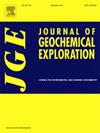赞比亚铜带Kafue河沿岸铜、钴污染沉积物扩散趋势
IF 3.3
2区 地球科学
Q1 GEOCHEMISTRY & GEOPHYSICS
引用次数: 0
摘要
河流是矿区金属(样物质)污染的重要途径。Kafue河流经有着近百年铜钴开采历史的赞比亚铜带。沿着750公里长的河段,在河流沉积物中钻取了9个2.5米深的岩心,并利用提取测试和扫描电子显微镜分析了颗粒大小、元素组成和矿物学,目的是研究时空污染模式。粉砂质和细粒至粗粒砂质沉积物沉积在天然堤防、半废弃曲流和河道坝中。其中Cu和Co污染较重,富集系数(EF)分别高达704和60,比影响最严重的欧洲大型河流高出一个数量级以上,Pb、as、U等元素污染较轻。铜的主要载体是孔雀石、假孔雀石、次生铁氢氧化物(铁水合石、针铁矿)、硫化物以及高岭石、绿泥石和云母的含铜颗粒。这种铜污染在卡富河流入铜带下游750公里处的沉积物中可追溯(EF高达13)。污染沉积物厚度为~100 cm ~ ~220 cm,平均沉积速率为~12 ~ ~27 mm/yr,表明污染的悬浮颗粒物可以沿河流快速沉积,具有潜在的环境危害。在早期成岩作用中,砷和铅可被清除成铁氧氢氧化物,并在地下水位以上的毛细条纹中富集。本文章由计算机程序翻译,如有差异,请以英文原文为准。
Trends of Cu and Co contaminated sediment dispersal along the Kafue River, the Zambian Copperbelt
Rivers are important pathways for metal(loid) contamination in mining areas. The Kafue River flows through the Zambian Copperbelt with nearly a hundred-year history of Cu and Co mining. Nine cores down to 2.5 m deep were drilled in fluvial sediments along a 750-km long river section and analysed for grain size, elemental composition, and mineralogy using extraction tests and scanning electron microscopy with an aim to investigate the spatial and temporal contamination patterns. The silty and fine- to coarse grained sandy sediments were deposited in natural levees, semi-abandoned meanders, and channel bars. They are heavily polluted by Cu reaching ore grade (up to 1.9 %) and Co, with UCC-based enrichment factors (EF) as high as 704 and 60, respectively, which is more than an order of magnitude higher than the most severely impacted large European rivers, and slightly polluted by Pb, As, U and other elements. The main carriers of Cu are malachite, pseudomalachite, secondary Fe oxyhydroxides (ferrihydrite, goethite), sulphides, and Cu-bearing grains of kaolinite, chlorite, and mica. This Cu contamination is traceable (EF up to 13) in sediments 750 km downstream of the Kafue River inflow to the Copperbelt. The contaminated sediments are ~100 cm to ~220 cm thick and their average sediment accumulation rates ~12 to ~27 mm/yr indicating that the contaminated suspended particulate matter can be rapidly deposited along the river, representing a potential environmental hazard. Arsenic and Pb can be scavenged to Fe oxyhydroxides and accumulate in capillary fringe above groundwater level during early diagenesis.
求助全文
通过发布文献求助,成功后即可免费获取论文全文。
去求助
来源期刊

Journal of Geochemical Exploration
地学-地球化学与地球物理
CiteScore
7.40
自引率
7.70%
发文量
148
审稿时长
8.1 months
期刊介绍:
Journal of Geochemical Exploration is mostly dedicated to publication of original studies in exploration and environmental geochemistry and related topics.
Contributions considered of prevalent interest for the journal include researches based on the application of innovative methods to:
define the genesis and the evolution of mineral deposits including transfer of elements in large-scale mineralized areas.
analyze complex systems at the boundaries between bio-geochemistry, metal transport and mineral accumulation.
evaluate effects of historical mining activities on the surface environment.
trace pollutant sources and define their fate and transport models in the near-surface and surface environments involving solid, fluid and aerial matrices.
assess and quantify natural and technogenic radioactivity in the environment.
determine geochemical anomalies and set baseline reference values using compositional data analysis, multivariate statistics and geo-spatial analysis.
assess the impacts of anthropogenic contamination on ecosystems and human health at local and regional scale to prioritize and classify risks through deterministic and stochastic approaches.
Papers dedicated to the presentation of newly developed methods in analytical geochemistry to be applied in the field or in laboratory are also within the topics of interest for the journal.
 求助内容:
求助内容: 应助结果提醒方式:
应助结果提醒方式:


